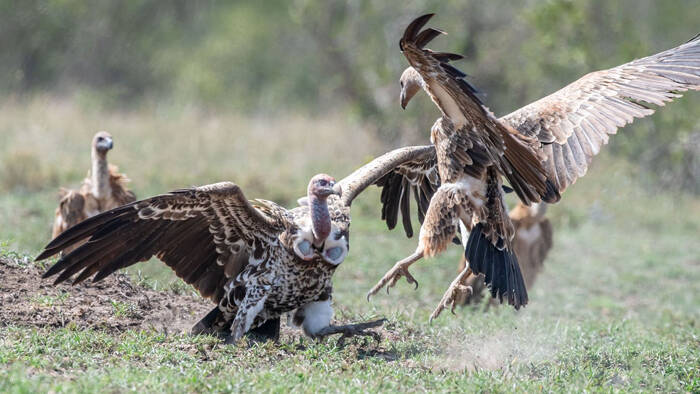Gyps bengalensis
IUCN
LCBasic Information
Scientific classification
- name:Gyps bengalensis
- Scientific Name:Gyps bengalensis,White-rumped Vulture,White-rumped vulture, white-rumped vulture
- Outline:Raptor
- Family:Falconiformes Accipitridae G.vultures
Vital signs
- length:83-120cm
- Weight:5-7kg
- lifetime:20-40years
Feature
Its claws are not sharp, so it cannot catch prey alive, and its head and neck are completely exposed.
Distribution and Habitat
Distributed in Afghanistan, Bhutan, Cambodia, India, Islamic Republic of Iran, Lao People's Democratic Republic, Myanmar, Nepal, Pakistan, Thailand, Vietnam.
Regional extinction: Bangladesh, China (only a small number of distribution in Yunnan Province), Malaysia.
Migrant bird: Brunei Darussalam, Russian Federation.
Inhabits open low mountains and hills or plains at the foot of the mountains, often moving around towns and villages in winter.
Appearance
The head is covered with yellow-white feathers and down feathers; the head and neck are gray with exposed areas, and the base of the neck has a collar composed of white down feathers. The upper body is sandy white or dark brown, with spear-like stripes and light-colored feather edges, the lower back is white, and there is a white band under the wings. The head and upper neck are bare, with sparse yellow ciliated feathers; there is a cluster of dirty white down feathers on the back of the neck; the shoulders, wings and tail are dark black; the lower back and waist are white; the chest, abdomen and undertail coverts are dark brown with light colors. Feather trunk pattern. Mouth gray green or lead gray. Feet dark greenish gray.
The head and neck of young birds have more hair-like feathers and down feathers than adult birds. The neck feathers are mostly long lanceolate feathers, with less down feathers, and the color is darker brown with wider white. Axis pattern; lower back and waist a
Details
White-rumped vulture is a medium-sized vulture, which is only found in Asia and has no subspecies.

White-rumped vulture is a gregarious animal that feeds on the ground or on rocky slopes, often in small groups. It is active during the day and rests in trees at night. The flight speed is generally 50 to 55 kilometers per hour, and the fastest speed can reach 90 kilometers per hour. The flight altitude can reach more than 2,700 meters. The call is like a hoarse complaint, and it makes a sharp cry when it sees a corpse. It often flies alone in the open lowland to search for food, and occasionally goes up to 1,500 meters in the bare rock area of the barren mountain to look for animal carcasses. After finding the carcass, the individuals who were originally scattered to find food quickly gathered together, screaming and fighting, and soon the carcass was pecked clean, and only when there was only a pile of bones left on the ground did they disperse again. Usually do not eat live animals, unless in special circumstances, generally do not actively attack people and animals, when food is scarce and hungry, also eat frogs, lizards, birds, small mammals and large insects. It feeds on animal carcasses.
This species may have been the most abundant large bird in the world, and the global population of this species is almost certainly in the millions. However, the global population has dropped sharply since the 1990s, and the estimated number of mature individuals is between 2,500 and 9,999. The actual number will not exceed 3,500-15,000 individuals.
The Deqin Taizi Snow Mountain in the northwest of Diqing Tibetan Autonomous Prefecture, Yunnan, China, has a peak altitude of about 5,000 meters. There are well-preserved alpine coniferous forests in the boreal primeval forest. The climate has a large vertical difference, showing typical three-dimensional climate characteristics. There are white-backed vultures in the reserve.
The Baimang Snow Mountain Nature Reserve in the east of Deqin County, Yunnan, China, is a relatively well-preserved boreal primeval forest area. It is also the highest altitude and largest nature reserve in Yunnan Province. There are also white-backed vultures in the reserve.
Listed in the "Red List of Endangered Species of the World Conservation Union" (IUCN) 2021 ver 3.1-Critically Endangered (CR).
Listed as a first-class protected animal in China. Approved by the State Council on December 10, 1988, issued by the Ministry of Forestry and the Ministry of Agriculture of the People's Republic of China on January 14, 1989, and implemented since January 14, 1989.
Listed in the first class of China's "National Key Protected Wildlife List" (February 5, 2021).
Protect wild animals and stop eating game.
Maintaining ecological balance is everyone's responsibility!








